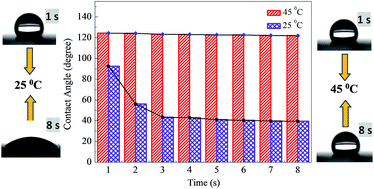Temperature-responsive zinc oxide nanorods arrays grafted with poly(N-isopropylacrylamide) via SI-ATRP
Abstract
Well fabricated ZnO nanorods (ZnO NRs) arrays with preferred-orientation that grown on pre-deposited ZnO seed layers substrate were selected to graft thermo-responsive polymers of poly(N-isopropylacrylamide) (PNIPAM) by surface-initiated atom transfer radical polymerization (SI-ATRP). As a controlled/“living” radical polymerization, SI-ATRP could endow the systems with the characteristics of the grafted PNIPAM, meanwhile, with the maintaining of the properties of the ZnO NRs. The structures of ZnO and the grafted polymer with the relatively high molecular weights (Mn, 24 300) and narrow molecular weight distributions (Mw/Mn, 1.19) that determined by GPC detection, were characterized by XRD and FT-IR. The graft amount of PNIPAM on ZnO NRs and the interactions between the two components were determined by TG and XPS, respectively. The relatively thin layers of PNIPAM (∼15 nm) formed around NRs via SI-ATRP method were observed by SEM. And the temperature-sensitivity of the grafted nanorods were proved by contact angles measurements. Furthermore, photodegradation of Rhodamine B (Rh-B) by the grafted nanorods revealed that ZnO NRs–PNIPAM exhibited photocatalysis and temperature responsibility characteristics, indicating the significant potential applications with tunable responsiveness by changing the environmental conditions.


 Please wait while we load your content...
Please wait while we load your content...